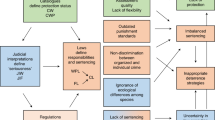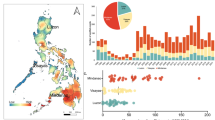Abstract
The Amazon is under threat due to an unprecedented attack on environmental legislation. The municipality of Manicoré, Brazil, is an example of how the weakening of laws affect the conservation of biodiversity in the region. Manicoré is characterized as a scientifically understudied area, with high biodiversity potential and is likely to contain many species not yet described. Recently, 801 species of angiosperms were listed for this municipality, and during the collection expeditions it was possible to verify the effects of the weakening of environmental policies and laws. In this work, we show how a set of local actions can affect the balance of power and economic exploitation in a region in the Amazon. The examples we highlight here help to understand the entire current context of conservation in the Amazon, as we dissect the details of the political dynamics that weaken the biodiversity protection network and accelerate the exploitation of natural resources in the region.


Similar content being viewed by others
Availability of data and materials
Not applicable.
Code availability
Not applicable.
References
ADAF–Agência de Defesa Agropecuária e Florestal do Estado do Amazonas (2021) Manicoré: Rebanho bovino salta de 134 mil para 165 mil em Matupí. Acrítica de Humaitá. https://acriticadehumaita.com.br/manicore-rebanho-bovino-salta-de-134-mil-para-165-mil-em-matupi/. Accessed on 15th Feb 2021
Brasil (2011) Lei Complementar No. 140, de 8 de dezembro de 2011. http://www.planalto.gov.br/ccivil_03/LEIS/LCP/Lcp140.htm/ Accessed on 11 Feb 2020
Brasil (2020) Projeto de Lei no. 191/20. https://www.camara.leg.br/proposicoesWeb/prop_mostrarintegra?codteor=1855498&filename=PL+191/2020. Accessed on 10 Feb 2020
Brasil (2022) Decreto No. 10.966, de 11 de fevereiro de 2022. https://www.in.gov.br/en/web/dou/-/decreto-n-10.966-de-11-de-fevereiro-de-2022-379739340. Accessed on 25 Feb 2022
Butler R (2021) Amazon deforestation jumps sharply in April. https://news.mongabay.com/2021/05/amazon-deforestation-jumps-sharply-in-april/ Accessed on 2 Mar 2022
Carvalho JB de (2010) Desmatamentos, grilagens e conflitos agrários no Amazonas. Valer, Manaus
Coelho CA, da Pereira MRS, Amorim BS (2020) Preliminary Angiosperm checklist in an area south of the Madeira River, Manicoré, Amazonas, Brazil. Acta Brasiliensis 4:1–29. https://doi.org/10.22571/2526-4338254
Curi MV (2007) Aspectos legais da mineração em terras indígenas. Revistas de Estudos e Pesquisas. http://www.funai.gov.br/arquivos/conteudo/cogedi/pdf/Revista-Estudos-e-Pesquisas/revista_estudos_pesquisas_v4_n2/Artigo_6_Melissa_Volpato_Aspectos_legais_da_mineracao.pdf. Acesssed on 8 Jun 2020
Farias E (2019) Amazônia em Chamas: madeira ilegal sai de terras indígenas e áreas protegidas. https://amazoniareal.com.br/amazonia-em-chamas-madeira-ilegal-sai-de-terras-indigenas-e-areas-protegidas/. Accessed on 21th Feb 2021.
Fearnside PM (2016) Environmental policy in Brazilian Amazonia: lessons from recent history. Novos Cadernos 19:27–46. https://doi.org/10.5801/ncn.v19i1.1379
Ferreira LV, Venticique E, Almeida S (2005) O desmatamento na Amazônia e a importância das áreas protegidas. Estudos Avançados 19:157–166. https://doi.org/10.1590/S0103-40142005000100010
Garcia B (2011) The Amazon from an international law perspective. Cambridge University Press, New York
Gatti LV, Basso LS, Miller JB et al (2021) Amazonia as a carbon source linked to deforestation and climate change. Nature 595:388–393. https://doi.org/10.1038/s41586-021-03629-6
Governo do Estado do Amazonas (2017) Amazonino entrega licenças ambientais a extrativistas em Manicoré e Humaitá e anuncia investimentos. http://www.amazonas.am.gov.br/2017/12/amazonino-entrega-licencas-ambientais-a-extrativistas-em-manicore-e-humaita-e-anuncia-investimentos/. Accessed on 5 Jan 2020
Hopkins MJG (2007) Modelling the known and unknown plant biodiversity of the Amazon Basin. J Biogeogr 34:1400–1411. https://doi.org/10.1111/j.1365-2699.2007.01737.x
Howe M (2013) Colombia backs eco-friendly gold production. https://www.mining.com/colombia-backs-eco-friendly-gold-production-38172/. Accessed on 25 Feb 2022
IBGE—Instituto Brasileiro de Geografia e Estatística (2004) Mapa de vegetação do Brasil. https://www.ibge.gov.br/. Accessed on 2 Jan 2020
IBGE—Instituto Brasileiro de Geografia e Estatística (2017) Mapa de localização do município de Manicoré. https://cidades.ibge.gov.br/brasil/am/manicore/panorama. Accessed on 2 Jan 2020
INPE (2020) A estimativa da taxa de desmatamento por corte raso para a Amazônia Legal em 2019 é de 9.762 km2. Instituto Nacional de Pesquisas Espaciais. http://www.inpe.br/noticias/noticia.php?Cod_Noticia=5294. Accessed on 20 Jul 2020
Leal MLM, Maniesi V (2018) O desflorestamento e suas relações com as legislações federais: uma análise sobre os assentamentos rurais do município de Manicoré/AM. Estudos Geográficos.http://www.periodicos.rc.biblioteca.unesp.br/index.php/estgeo/article/download/12270/8643/. Accessed on 13 Jan 2020
Leal MLM, da Silva VV, Fulan JA, de Souza AL (2017) Uso da terra e a legislação florestal no Projeto de assentamento Matupi, AM. Boletim De Geografia 35:122–133. https://doi.org/10.4025/bolgeogr.v35i1.31897
Leite-Filho AT, Soares-Filho BS, Davis JL, Abrahão GM, Börner J (2021) Deforestation reduces rainfall and agricultural revenues in the Brazilian Amazon. Nat Commun 12:2591. https://doi.org/10.1038/s41467-021-22840-7
Levis C, Flores BM, Mazzochini GG, Manhães AP, Campos-Silva JV, de Amorim PB, Peroni N, Hirota M, Clement CR (2020) Help restore Brazil’s governance of globally important ecosystem services. Nat Ecol Evol 4:172–173. https://doi.org/10.1038/s41559-019-1093-x
Lima SMSA, Façanha AC, Lopes WGR (2017) Urbanização e crescimento populacional: reflexões sobre a cidade de Teresina, Piauí. Gaia Scientia 11:31–51. https://doi.org/10.22478/ufpb.1981-1268.2017v11n1.34864
Mapbiomas (2022a) Cobertura. https://plataforma.brasil.mapbiomas.org/coberturamanicore. Accessed on 27 Feb 2022a.
Mapbiomas (2022b) Queimadas. https://plataforma.brasil.mapbiomas.org/firemanicore. Accessed on 27 Feb 2022b
Maretti CC, Riveros SJC, Hofstede R, Oliveira D, Charity S, Granizo T, Alvarez C, Valdujo P, Thompson C (2014) State of the Amazon: Ecological Representation in Protected Areas and Indigenous Territories. WWF Living Amazon (Global) Initiative. Brasília e Quito.
Menegassi D (2021) Mineração em Terras Indígenas, regularização fundiária e mais, entenda as prioridades de Bolsonaro para 2021. https://www.oeco.org.br/noticias/mineracao-em-terras-indigenas . Accessed on 19 Jul 2021
Pinheiro L (2022) Decreto de Bolsonaro sobre ‘mineração artesanal’ é incentivo ao garimpo ilegal na Amazônia, apontam ambientalistas. https://g1.globo.com/meio-ambiente/noticia/2022/02/14/decreto-que-estimula-mineracao-artesanal-visa-legalizar-garimpo-apontam-ambientalistas.ghtml. Accessed on 25 Feb 2022
Sharlon I (2021) Planta da Amazônia pode substituir uso de mercúrio na busca por ouro. https://realtime1.com.br/dia-a-dia/planta-da-amazonia-pode-substituir-uso-de-mercurio-na-busca-por-ouro/. Accessed on 25 Feb 2022
Silva KE, Pereira KP (2005) Alterações na cobertura vegetal natural dos municípios do Sul do Amazonas. Anais XII Simpósio Brasileiro de Sensoriamento Remoto. http://marte.sid.inpe.br/col/ltid.inpe.br/sbsr/2004/11.22.09.51/doc/1667.pdf. Accessed on 7 Mar 2020
Smith ID (2012) Exploring the source of green gold. Consilience 1:97–102. https://doi.org/10.7916/consilience.v0i7.4578
Sudam (2020) Legislação da Amazônia. http://www.sudam.gov.br/index.php/convenios-termos-cooperacao/58-acesso-a-informacao/86-legislacao-da-amazonia/. Accessed on 18 Feb 2020
Tavares LFS, Cordeiro L (2017) Perfil socioeconômico e ambiental do sul do estado do Amazonas: Subsídios para Análise da Paisagem. WWF Estudo. https://d3nehc6yl9qzo4.cloudfront.net/downloads/perfil_sul_amazonas.pdf. Accessed on 17 Feb 2020
Ter Steege H, Vaessen RW, López DC, Sabatier D, Antoneli A, de Oliveira SM, Pitman N, Jørgensen PM, Salomão R, Gomes VHF (2016) A descoberta da flora arbórea da Amazônia com uma lista atualizada de todos os taxa arbóreos conhecidos. Boletim Do Museu Paraense Emílio Goeldi. 11:231–261. https://doi.org/10.1038/srep29549/20
Tilio Neto PDA (2010) Amazônia brasileira. In: Soberania e ingerência na Amazônia brasileira. Centro Edelstein de Pesquisa Social, Rio de Janeiro
Tourneau FL, Bursztyn M (2010) Assentamentos rurais na Amazônia: contradições entre a política agrária e a política ambiental. Ambiente & Sociedade 13:111–130. https://doi.org/10.1590/S1414-753X2010000100008
Vale MM, Berenguer E, de Menezes MA, de Castro EBV, de Siqueira LP, Rita de Cássia QP (2021) The COVID-19 pandemic as an opportunity to weaken environmental protection in Brazil. Biol Cons 255:108994. https://doi.org/10.1016/j.biocon.2021.108994
Vieira ICG, de Toledo PM, Higuchi H (2018) A Amazônia no Antropoceno. Ciência e Cultura 70:56–59. https://doi.org/10.21800/2317-66602018000100015
Vilela PR (2019) Bolsonaro diz que ministério prepara projeto para legalizar garimpos. https://agenciabrasil.ebc.com.br/politica/noticia/2019-08/bolsonaro-diz-que-ministerio-prepara-projeto-para-legalizar-garimpos. Accessed on 25 Feb 2022
White BLA (2018) Spatiotemporal variation in fire occurrence in the state of Amazonas, Brazil, between 2003 and 2016. Acta Amazônica 48:358–367. https://doi.org/10.1590/1809-4392201704522
Acknowledgements
The first author thanks Dr. Marta Regina Pereira for all the conversations that led to the production of this manuscript, as well as the revisions and improvement of the text. Albertina Ferraz, Antônio Soares, Elicleuson Ramos, Jeremias Pereira, Jone Bitencourt, Neiza Paixão and Robert Kennedy for the partnership in the collection of data regarding the mining processes in the city of Manicoré, Amazonas. To the National Council for Scientific and Technological Development—CNPq for conceding the Master’s grant, process #130808/2020-2. Bruno Sampaio Amorim thanks the Coordination for Improvement of Higher Level Personnel-CAPES for the Postdoctoral Fellowship, process #88882.315044/2019-01. The authors also thank Dr. Dirce Komura for reviewing the manuscript and improving the text, and the PAPAC FAPEAM project and the Graduate Program in Biological Sciences (Botany) of the National Institute for Amazonian Research, for funding for translation of this article.
Funding
This research received funding for translation, from the PAPAC FAPEAM project via the Post-Graduate Program in Biological Sciences (Botany)—PPGBOT at the National Institute of Amazonian Research—INPA. During the writing of the manuscript, Caroliny Almeida Coelho received financial support from the National Council for Scientific and Technological Development-CNPq, in the form of a Master’s grant, process #130808/2020-2. Bruno Sampaio Amorim received financial support from the Coordination for Improvement of Higher Level Personnel-CAPES, in the form of a postdoctoral fellowship, process #88882.315044/2019-01.
Author information
Authors and Affiliations
Contributions
CAC and BSA idealized the work. Field observations and data collection were performed by CAC and discussed with BSA. The first draft of the manuscript was written by CAC and all the authors commented on the earlier versions of the manuscript. Figure 1 was elaborated by JRM, and Fig. 2 was elaborated by BSA. All authors read and approved the final manuscript.
Corresponding author
Ethics declarations
Conflicts of interest
Not applicable.
Ethical approval
Not applicable.
Consent to participate
Not applicable.
Consent for publication
Not applicable.
Additional information
Communicated by Pedro V. Eisenlohr.
Publisher's Note
Springer Nature remains neutral with regard to jurisdictional claims in published maps and institutional affiliations.
Rights and permissions
About this article
Cite this article
Coelho, C.A., Maciel, J.R., Cabral, F.N. et al. Anatomy of a crime: the network of actions that threaten the conservation of the Amazon. Biodivers Conserv 31, 1755–1763 (2022). https://doi.org/10.1007/s10531-022-02424-7
Received:
Revised:
Accepted:
Published:
Issue Date:
DOI: https://doi.org/10.1007/s10531-022-02424-7




